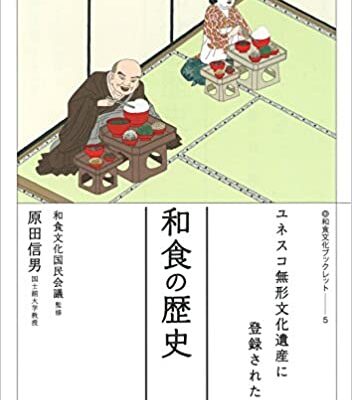原田信男 著「和食の歴史」 思文閣出版
本書では、和食の歴史の始めの方に「神鐉料理」を紹介しています。そして、貴族が愛した大饗料理、仏教と入ってきた精進料理、中世の本膳料理、茶会で発展した懐石料理などを時代の流れ順に解説していきます。
神鐉料理の説明を見てみます。神事が始まると、神に神饌を備えて、祝詞の奏上を行う間に、神様が神饌を食されます。そして、神事が終了した後、参加者一同で直会(なおらい)に移動し、神饌として供えられたものを肴に飲み食いを始めます。この直会というのは単なる宴会ではなく、神が食べたものを、参加者一同で食べるので、神と一緒に食事をしたことになります。
直会において、神人共食をすることによって、「神様と同じ心を共有し、人々の願いを神様に叶えてもらうことが、大切な神饌料理の目的」なのだそうです。
なお、神に供える神饌ですから、見た目も美しい必要があります。盛り付け、特に高く、そして美しく見せる点に心血が注がれました。和食が見た目にも美しくあるのは、この神饌料理に源流があると考えられます。
日本料理は、切る技術を大切にしていますが、切ることは、まさに料理そのものです。片刃の薄く鋭い包丁で魚肉を切ると、細胞を破壊することなく切断します。これにより、魚肉の肉汁や脂が完全に閉じ込められ、刺身を美味しく感じるとのことです。
ちなみに、料理屋が発達したのは近世になってからで、そこでは誰でも何時でも、お金さえあれば自由に料理を楽しむことができるようになりました。これは料理史上の大きな変化でもありました。
他にも、今まで知らなかったことが次々出てきますので、読んでいて楽しいです。通訳ガイドさんの場合は、細かい知識よりも、日本料理について、歴史の面から2~3の蘊蓄を語れるようになると、説明に深みが増すと思います。(完)
“History of Japanese Food” by Nobuo Harada, Shibunkaku Publishing Co.
This book introduces “God Selection Cuisine” at the beginning of the history of Japanese food. Then, in chronological order, the book explains the “Daikyo” cuisine loved by the aristocracy, the “Shojin” cuisine that came with Buddhism, the “Honzen” cuisine of the Middle Ages, and “Kaiseki” cuisine that developed at tea ceremonies.
Let’s take a look at the description of the God Selection Cuisine. At the beginning of the ritual, a food offering is prepared for the deity, and the deity eats the food while the celebrant performs the ritual prayer. After the ritual is over, all participants move to Naorai, where they start eating and drinking with the food offered as a food offering. This Naorae is not a mere banquet, but rather, the participants eat together what the gods have eaten, which means that they have eaten together with the gods.
The purpose of the “God eats food with people” is to share the same mind with God and to ask God to grant the wishes of the people by eating together with the gods.
In addition, since the food is offered to the gods, it must be beautiful to look at. Much effort was put into the arrangement of the food, especially in making it look high and beautiful. The reason why Japanese food is beautiful to the eye is thought to have its origin in this process.
Japanese cuisine places great importance on the art of cutting, and cutting is truly cooking itself. Cutting fish meat with a thin, sharp, single-edged knife cuts without destroying the cells. This locks in the juices and fat of the fish meat completely, making the sashimi taste delicious.
Incidentally, it was not until the early modern period that the cookhouse developed, where anyone could freely enjoy food at any time of the day, as long as they had money. This was also a major change in culinary history.
It is fun to read about other things I had never heard of before, because they keep coming up. For interpreter-guides, I think it would add depth to their explanations if they can talk about Japanese cuisine from a historical perspective, rather than detailed knowledge, with two or three bits of knowledge. (End)
“Histoire de la nourriture japonaise” par Nobuo Harada, Shibunkaku Publishing Co.
Ce livre présente la “cuisine de la sélection divine” au début de l’histoire de la nourriture japonaise. Ensuite, dans l’ordre chronologique, le livre explique la cuisine “Daikyo” aimée par l’aristocratie, la cuisine “Shojin” venue avec le bouddhisme, la cuisine “Honzen” du Moyen Âge et la cuisine “Kaiseki” qui s’est développée lors des cérémonies du thé.
Jetons un coup d’œil à la description de la Cuisine de la Sélection des Dieux. Au début du rituel, une offrande alimentaire est préparée pour la divinité, et celle-ci mange la nourriture pendant que le célébrant effectue la prière rituelle. Une fois le rituel terminé, tous les participants se rendent au Naorai, où ils commencent à manger et à boire avec la nourriture offerte en guise d’offrande. Ce Naorae n’est pas un simple banquet, mais au contraire, les participants mangent ensemble ce que les dieux ont mangé, ce qui signifie qu’ils ont mangé ensemble avec les dieux.
L’objectif du “Dieu mange de la nourriture avec les gens” est de partager le même esprit que Dieu et de demander à Dieu d’exaucer les souhaits des gens en mangeant ensemble avec les dieux.
De plus, comme la nourriture est offerte aux dieux, elle doit être belle à regarder. Beaucoup d’efforts étaient consacrés à la disposition des aliments, notamment pour qu’ils soient hauts et beaux. On pense que la raison pour laquelle la nourriture japonaise est belle à l’œil trouve son origine dans ce processus.
La cuisine japonaise accorde une grande importance à l’art de la découpe, et la découpe est véritablement la cuisine elle-même. La découpe de la chair du poisson à l’aide d’un couteau fin, tranchant et à un seul tranchant coupe sans détruire les cellules. Cela permet d’emprisonner complètement les jus et les graisses de la chair du poisson, ce qui rend le sashimi délicieux.
D’ailleurs, ce n’est qu’au début de la période moderne que se développe le cookhouse, où chacun peut librement profiter de la nourriture à tout moment de la journée, pour autant qu’il ait de l’argent. Il s’agit également d’un changement majeur dans l’histoire culinaire.
C’est amusant de lire d’autres choses dont je n’avais jamais entendu parler auparavant, car elles reviennent sans cesse. Pour les guides-interprètes, je pense que cela ajouterait de la profondeur à leurs explications s’ils pouvaient parler de la cuisine japonaise d’un point de vue historique, plutôt que de connaissances détaillées, avec deux ou trois bribes de savoir. (Fin)
